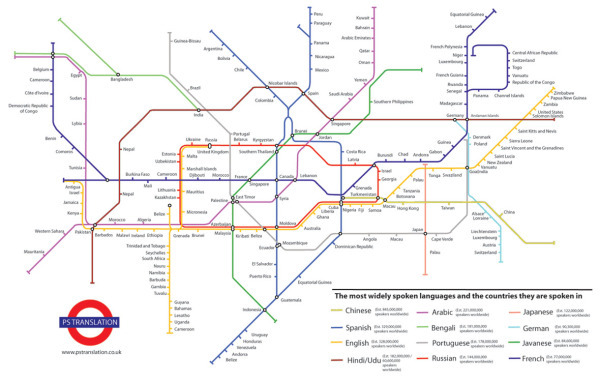The Most Widely Spoken Languages of the World
A subway map style infographic, The Most Widely Spoken Languages of the World, shows some of the primary countries and the languages they speak. Each track is a different language, and the connection point are countries where that language is one of the dominant languages. The actual number estimates behind how many people speak each of the top languages is listed in the legend.
I don’t know how accurate it is because the data source isn’t listed. I would think that the U.S. would at least be a junction point between English and Spanish (and maybe others).
This infographic illustrates the most widely spoken languages in the world and some of the countries these languages are spoken in. The station name indicates the language and the number of speakers that languages has and the map illustrates some of the countries these languages are spoken in. The list of countries is not exhaustive but can help the viewer navigate the world of languages.
The inspiration for this map came from the London Underground map – which in fact is not a map but a schematic diagram. As a schematic diagram it shows not the geographic but the relative positions of stations along the lines, stations’ connective relations with each other and their fare zone locations.
This infographic has been commissioned by PS Translation to showcase their range of translation services.
I also think this is a fantastic example of a infographic used for marketing purposes. It’s not an outright advertisement, but it is certainly a related topic to a translation service done in a very appealing design style.
Thanks for the link James!









 Randy
Randy

Reader Comments (18)
The numerous mistakes aside, it's bad because although it does show some genuine connections in a visual way it includes so many extra bits of info (physical location, order of countries) that add nothing, and just confuse.
terribble chart. If you insist on making, yet another, subway map-chart thing, please do it acurately..
I didn't know people speak Javanese in France, several countries are duplicated,
there are a lot of French speaking in Magreb (Marocco, Tunisia and Algeria),
connections without countries ...
Let's launch a project to get that sorted out correctly ...
The purpose of the ‘map’ was to illustrate in how many countries certain languages (e.g. Spanish) were spoken in and also show a selection of those countries (although not all of them)
I like the concept and as an image, the picture (I think) is aesthetically pleasing. That said I would like to make this usable so I welcome you feedback on how you think I should do this. What do you think would take this from badly executed to well executed?
To take this from badly executed to well executed, you'll have to examine the data, determine what relationships, patterns, trends, details, and other aspects to highlight, then consider the best way to present that metadata using imagery. I'd love to see the next version!
Its’ back to the drawing board for us then –looking forward to challenge - I’ll keep you posted on the progress.